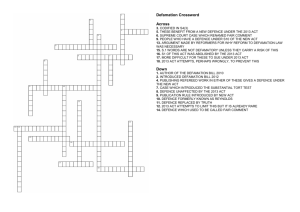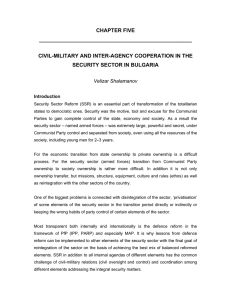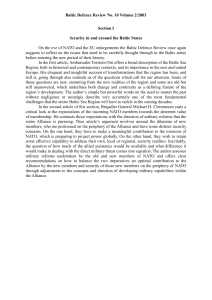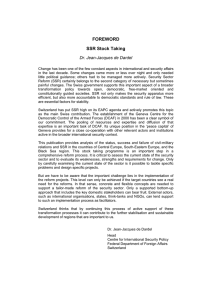Integrated Defence Planning: From National Security Policy to Force Planning Todor Tagarev
advertisement
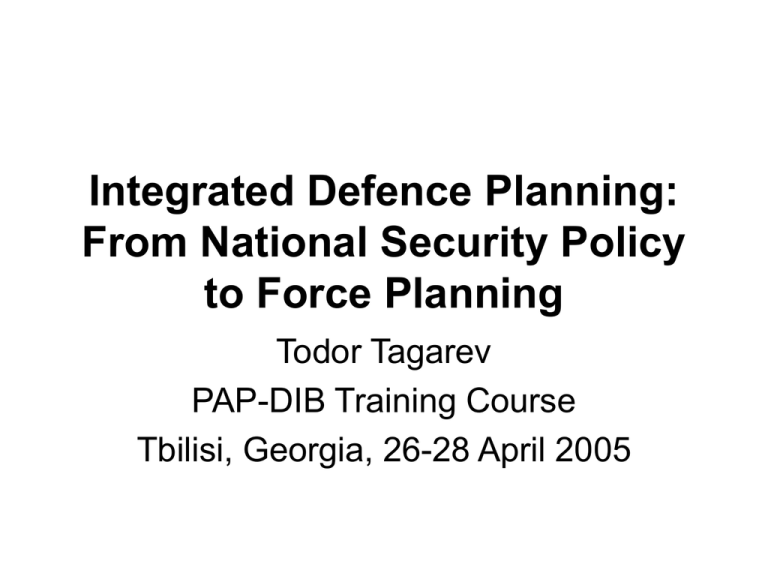
Integrated Defence Planning: From National Security Policy to Force Planning Todor Tagarev PAP-DIB Training Course Tbilisi, Georgia, 26-28 April 2005 Affiliation • Associate Professor and Chair, Defence and Force Management Department, “Rakovski” Defence and Staff College, Sofia • Program Director, Centre for National Security and Defence Research, Bulgarian Academy of Sciences • Managing Editor, Information & Security: An International Journal, http://infosec.procon.bg • E-mail: – tagarev@gmail.com – infosec@procon.bg Outline • Roles of the armed forces in the security strategy (Bartlett’s model) • Alternative approaches to defence planning • Long-term defence planning (Capabilitiesbased planning) • Building blocks in allied force planning; security sector capabilities Armed forces in the security strategy • • • • • • • Ends Means Strategy Risk Security environment Resource constraints Possible roles of the armed forces Objectives of the national security policy Strategies for contribution of the armed forces Missions of the armed forces, 1...m Tasks of the armed forces, 1...t Allied and other external requirements Capabilities, 1...c Force mix, 1...f Structure Manning Training Weapons& Equipment Stockpiles Costing the force structure C4ISR Infrastructure Doctrine Readiness Assessing planning risk Yes No Affordable force structure & Acceptable planning risks Alternative approaches to defence planning 1. 2. 3. 4. 5. 6. 7. 8. Top-down Bottom-up Scenario Threat Mission Hedging Technology Fiscal Objectives of the national security policy Strategies for contribution of the armed forces Missions of the armed forces, 1...m Tasks of the armed forces, 1...t Allied and other external requirements Capabilities, 1...c Force mix, 1...f Structure Manning Training Weapons& Equipment Stockpiles Costing the force structure C4ISR Infrastructure Doctrine Readiness Assessing planning risk Yes No Affordable force structure & Acceptable planning risks Planning horizons • Long-term planning – 10-30 years • Mid-term planning – 4-8 years (6 years in NATO and a number of member countries; DPQ/IOS) • Short-term planning (budget, procurement plans, plans for training and exercises, etc.) Long-term defence planning • • • • Objectives Place Best-practice model Handbook on Long Term Defence Planning, RTO Technical Report 69 (Paris, NATO Research and Technology Organization/ SAS Panel, April 2003), www.rta.nato.int Policy Formulation (1a) Scenario Development (1b) Environmenta Assessment (1c) Campaign Option Development (2) Cost/ Effectiveness Testing (4) Force Proposing Concurrency Testing Force Structuring (5) (3) Current/Future Force Estimation (1d) Total force Costing (6) Cost/ Risk Tradeoff Analysis (8) Structure Development Assessment (9) (7) Scenario set in the defence planning process in Canada 1. Search and rescue in Canada 2. Disaster relief in Canada 3. International humanitarian assistance 4. Surveillance/control of Canadian territory and approaches 5. Evacuation of Canadians overseas 6. Peace support operations (Peacekeeping) 7. Aid of the civil power/Assistance to law enforcement agencies 7. a. Chemical Weapon Variant Scenario set, Canada (cont.) 8. National sovereignty/interests enforcement 9. Peace support operations (Peace enforcement) 9. a. Failed State Variant 10. Defence of North America 10. a. Radiological Weapon Variant 10. b. Cyber Attack Variant 11. Collective Defence Partial algorithm • Tasks to accomplish a mission in a scenario • Effects needed to achieve the task • Enabling concepts • Capabilities needed to implement effects • Capability Requirements • (NATO - TOA) Building blocks in force planning • General framework • NATO and EU context • Planning in the context of the national security sector CAPABILITIES Task: Control of the Airspace 1. Recognized Air Picture (Air surveillance) 2. Command and control (awareness, early warning, decision making, communications, navigation, etc.) 3. Defeat/ Repel enemy aircraft 4. Sustained operations (Logistics) Capability Requirements vs. Resources – Approach I I Defining required capabilities II Designing “type units” (unit models) with detailed description of unit mission, organisation, manning, weapon systems and training levels III Costing type units IVOptimising the mix of type units Air Force Example Task: Airspace Control UNIT TYPES - Capability 1 Unit U1 U2 U3 U4 U5 U6 Type Fighters type A Fighters type B Fighters type B AD Sq. type A AD Sq. type B AD Sq. type C Qnt. 18 24 12 6 6 3 People P1 P2 P3 P4 P5 P6 $ C1 C2 C3 C4 C5 C6 Example: Task 1 Force Mix Assessment Mix Combat Units Combat Support Combat Service Support $ 1 Command 2 maint. CM1 post + 1 signal sqs + 1 log 1*U4 battalion battalion 1*U1+1* CM2 ... ... U4+2*U5 CM3 ... ... ... Associated risk M1 2*U1 + R1 M2 R2 M3 … ... R3 Balancing Requirements and Resources • Straightforward non-linear optimization problem regarding capability X: Choose Force Mixi : Risk is minimal, Resource Reqs Expected Resources • 2 major complications – The resources available for capability X are not known in advance – Supplementarity of capabilities and tasks Force planning in international/ multi-agency context • Specialization vs full-spectrum • Interoperability – Readiness levels –… Alliance/ Security Sector Capabilities 100 % Conclusion • Politicians and experts • Organizational processes • Role of partnership • Questions?


